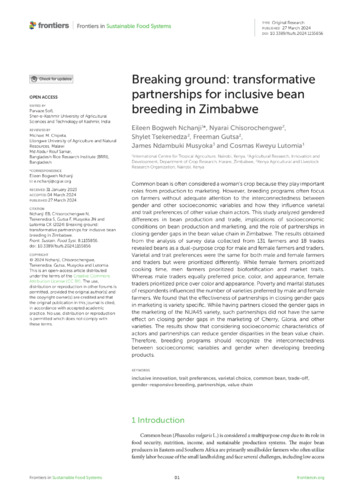Breaking ground: Transformative partnerships for inclusive bean breeding in Zimbabwe
Common bean is often considered a woman’s crop because they play important roles from production to marketing. However, breeding programs often focus on farmers without adequate attention to the interconnectedness between gender and other socioeconomic variables and how they influence varietal and trait preferences of other value chain actors. This study analyzed gendered differences in bean production and trade, implications of socioeconomic conditions on bean production and marketing, and the role of partnerships in closing gender gaps in the bean value chain in Zimbabwe. The results obtained from the analysis of survey data collected from 131 farmers and 18 trades revealed beans as a dual-purpose crop for male and female farmers and traders. Varietal and trait preferences were the same for both male and female farmers and traders but were prioritized differently. While female farmers prioritized cooking time, men farmers prioritized biofortification and market traits. Whereas male traders equally preferred price, color, and appearance, female traders prioritized price over color and appearance. Poverty and marital statuses of respondents influenced the number of varieties preferred by male and female farmers. We found that the effectiveness of partnerships in closing gender gaps in marketing is variety specific. While having partners closed the gender gaps in the marketing of the NUA45 variety, such partnerships did not have the same effect on closing gender gaps in the marketing of Cherry, Gloria, and other varieties. The results show that considering socioeconomic characteristics of actors and partnerships can reduce gender disparities in the bean value chain. Therefore, breeding programs should recognize the interconnectedness between socioeconomic variables and gender when developing breeding products.

